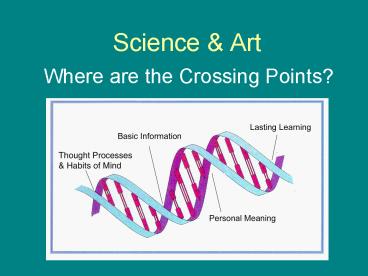Science - PowerPoint PPT Presentation
1 / 19
Title:
Science
Description:
can reprocess to plastic. Fired chemical change. will not dissolve in water ... In art or science do an experiment with bone dry and bisqued clay to observe the ... – PowerPoint PPT presentation
Number of Views:31
Avg rating:3.0/5.0
Title: Science
1
Science Art
- Where are the Crossing Points?
2
Basic Processes Are Alike
3
Scientific Process Artistic
ProcessRequires Requires
- Close observation
- Seeing patterns
- Careful lab habits
- Seeking and seeing new frames of reference
- Reflection on possibilities and results
- Close observation
- Seeing patterns
- Careful workmanship
- Seeking and seeing new frames of reference
- Reflection on possibilities and results
4
Standards and Elements Intersect
- Scientists use the creative thinking that the
arts nurture - Art uses science knowledge
- Examples include
- Light color theory
- Chemistry in clay and glazes
- Chemistry in paint pigment and binders
5
Grade 3 Example
- Science GPS
- Organisms have habitats
- Art Standards/Elements
- Artwork reflecting a range of concepts ideas,
subject matter - Formal qualities of art
- Media and technique
- Artist as researcher
Observational paintings of landscapes (landforms)
of habitats found in Georgia research and
include appropriate plants and animals for the
habitat selected research could be done in
science class prior to art class paintings taken
back to classroom to write about in science class
6
Grade 4 Example
- Science GPS
- Nature of Light
- Art Standards
- Understands and applies media, techniques, and
processes
Watercolor Painting transparent, translucent and
opaque paint media how watercolorists use the
transparency of the medium to create tints of
colors color wheel and pigment based color
theory compared and contrasted to the spectrum
seen with a prism
7
Transparent? Translucent? Opaque? Why?
8
Grade 5 Example
- Science GPS
- Classify organisms
- Art Standards
- Reflects on and assesses characteristic and
merits of artwork - Critical thinking skills and perceptual awareness
necessary to understand and produce art
Classify different styles of art relate the
process to scientific classification of
organisms.
9
True Integration Keeps The Validity of Both
Disciplines
- But adds power to learning in both
- Art validates science
- Science enhances art
10
How can it work?
- Pre-teaching (before)
- Concurrent teaching
- Reinforcement (after)
11
Pre-Teaching
- 4th Grade Survival or Extinction of Organisms
- Clay Sculpture Unit Invent, plan sculpt a
creature with all adaptive features needed to
survive in selected habitat - Take to science class to create habitat in which
it will live and - Write how each adaptive feature helps creature
survive
12
Concurrent Teaching
- 5th Grade Science Physical and chemical changes
- Clay Unit stages of clay
- Plastic malleable
- Bone Dry physical change
- water evaporated
- dissolves in water
- can reprocess to plastic
- Fired chemical change
- will not dissolve in water
- permanent chemical change
- In art or science do an experiment with bone dry
and bisqued clay to observe the above write up
in experiment form
13
Concurrent Teaching
- 4th Grade Science
- weather patterns and measurement severe weather
research paper - Computer Art Unit
- create computer art image, based on research, as
cover for severe weather report - Place appropriately altered self-portrait into
severe weather event
14
Severe Weather / Computer Art Units
15
Reinforcement
- 3rd Grade Rocks and Soils
- Art Natural Pigment Paintings
- Minerals as pigments in paint and other art
materials - Show minerals and other pigment in natural form,
as pigment, as paint
16
Natural Pigments From Rocks Minerals
17
How to make it happen?
- Classroom and art teacher review science GPS and
Art QCC or local art curriculum - Identify natural crossing points
- Look at year-long pacing/units and plan for
pre-teaching, concurrent teaching or
reinforcement of - Art in science and
- Science in art
- Identify common vocabulary and non-common but
related vocabulary to stress in both classes
18
Why do it?
- Motivated Learners
- Personal Meaning
- Deep, lasting learning
19
- Prepared by
- Denise Jennings
- Coordinator of Art Drama Education
- Fulton County Schools
- jennings_at_fultonschools.org
- With thanks to
- Fulton County Art Teachers
- Marylou Andrews
- Kacey Ciprari-Murphy
- Stephanie Menke
- Nancy Reed































